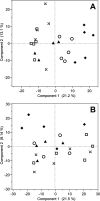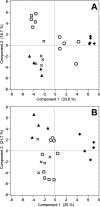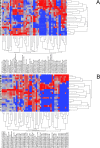Temperament type specific metabolite profiles of the prefrontal cortex and serum in cattle
- PMID: 25927228
- PMCID: PMC4416037
- DOI: 10.1371/journal.pone.0125044
Temperament type specific metabolite profiles of the prefrontal cortex and serum in cattle
Abstract
In the past decade the number of studies investigating temperament in farm animals has increased greatly because temperament has been shown not only to affect handling but also reproduction, health and economically important production traits. However, molecular pathways underlying temperament and molecular pathways linking temperament to production traits, health and reproduction have yet to be studied in full detail. Here we report the results of metabolite profiling of the prefrontal cortex and serum of cattle with distinct temperament types that were performed to further explore their molecular divergence in the response to the slaughter procedure and to identify new targets for further research of cattle temperament. By performing an untargeted comprehensive metabolite profiling, 627 and 1097 metabolite features comprising 235 and 328 metabolites could be detected in the prefrontal cortex and serum, respectively. In total, 54 prefrontal cortex and 51 serum metabolite features were indicated to have a high relevance in the classification of temperament types by a sparse partial least square discriminant analysis. A clear discrimination between fearful/neophobic-alert, interested-stressed, subdued/uninterested-calm and outgoing/neophilic-alert temperament types could be observed based on the abundance of the identified relevant prefrontal cortex and serum metabolites. Metabolites with high relevance in the classification of temperament types revealed that the main differences between temperament types in the response to the slaughter procedure were related to the abundance of glycerophospholipids, fatty acyls and sterol lipids. Differences in the abundance of metabolites related to C21 steroid metabolism and oxidative stress indicated that the differences in the metabolite profiles of the four extreme temperament types could be the result of a temperament type specific regulation of molecular pathways that are known to be involved in the stress and fear response.
Conflict of interest statement
Figures



References
-
- Fordyce G, Dodt RM, Wythes JR. Cattle temperaments in extensive beef herds in northern Queensland. 1. Factors affecting temperament. Aust J Exp Agric. 1988; 28: 683–687.
-
- Van Reenen CG, Van der Werf JTN, O'Connell NE, Heutinck LFM, Spoolder HAM, Jones RB, et al. Behavioural and physiological responses of heifer calves to acute stressors: long-term consistency and relationship with adult reactivity to milking. Appl Anim Behav Sci. 2013; 147: 55–68.
-
- Müller R, von Keyserlingk MAG. Consistency of flight speed and its correlation to productivity and to personality in Bos taurus beef cattle. Appl Anim Behav Sci. 2006; 99: 193–204.
-
- Hemsworth PH, Coleman GJ, Barnett JL, Borg S. Relationships between human-animal interactions and productivity of commercial dairy cows. J Anim Sci. 2000; 78: 2821–2831. - PubMed
Publication types
MeSH terms
LinkOut - more resources
Full Text Sources
Other Literature Sources
Miscellaneous

